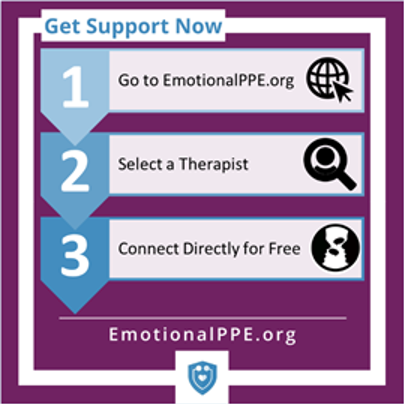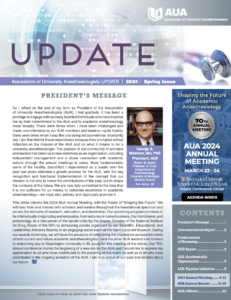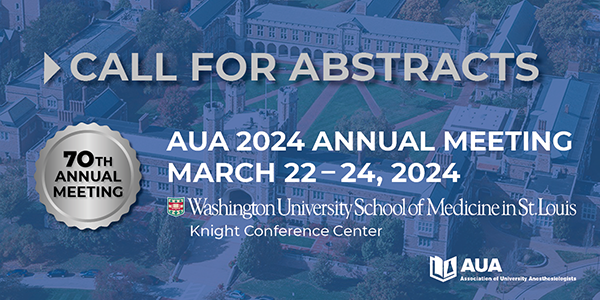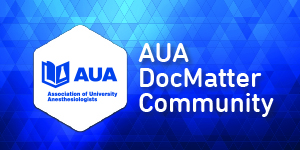Emotional PPE: Protecting Healthcare Workers’ Mental Health
Background
Much has been written about “flattening the curve” to avoid overburdening our healthcare system. The spotlight has primarily focused on availability of hospital and ICU beds, ventilators, medications, personal protective equipment (PPE), and other material resources. There has been less focus on a different limited resource, however, which is being quickly depleted - the mental health and wellbeing of healthcare professionals (HCPs).
Current stressors are varied and numerous. In some settings, limited availability of PPE and strict hospital policies have left many HCPs caring for patients without feeling optimally protected. In turn, they worry that they are putting their families at increased risk. Many are socially isolating or quarantining. Workplace rules, as well as prescribed roles and responsibilities, are constantly changing, which can make HCPs feel out of place and unprepared. On top of this, HCPs are witnessing profound human suffering. Patients are scared and institutional policies limit the family visitation that could otherwise provide them comfort. Even at end-of-life, many institutional policies do not allow for families to gather. Many HCPs silently grieve with families while feeling helpless in these circumstances.
Even though HCPs often put on a brave face as they fulfill the duties to their patients, colleagues, and communities, many are suffering. They worry about our own health and that of their family’s. Some feel a constant hum of anxiety or pressure. Others find themselves crying more easily or unable to sleep. Still others find that they have a much shorter fuse when dealing with other life issues. This is not business as usual, and with multiple future peaks of COVID-19 predicted, there is no definite end in sight.
The Mental Health Impact
Before COVID-19, HCPs were already at increased risk for mental illness, addiction, and suicide 1, 2. The current pandemic has created unprecedented stressors and traumas for this population. Recent high-profile suicides of a New York emergency department physician and an EMT have highlighted to the public the mental health impact of COVID-19 on HCPs. In addition, recent research studies have provided empirical data illustrating the problem. Rossi et al 3 found that 50% of healthcare workers surveyed in Italy had signs of post-traumatic stress disorder (PTSD) and 25% had signs of severe depression. Lai et al 4 surveyed 1257 doctors and nurses in China and found that 50% had signs of depression.
Studies of HCPs in previous crises have found that PTSD is more likely to occur in employees who experience the following: witnessing death 5, carrying out roles outside of one’s usual remit 6, and perception of personal threat 7. All these factors occur on a daily basis among HCPs during the COVID crisis.
Getting Help
It is common in healthcare to ignore physical symptoms of any illness and “carry on” with clinical duties. Many institutions have therefore created policies around what symptoms require intervention for possible COVID-19 infection. To our knowledge, however, no such policies have been widely adopted for monitoring mental health in HCPs. Given the empirical data showing a disproportionately high prevalence of mental distress in HCPs coupled with the pervasive reluctance of HCPs to seek services 8, it is clear that the mental health needs in HCPs are not being sufficiently addressed.
Table 1 lists physical symptoms of COVID-19 9 that are commonly self-assessed on a regular basis by HCPs as part of hospital policies. We propose an analogous list of psychological symptoms to be self-assessed by HCPs. The list presented is a modified version of the Pentagon Post Disaster Health Assessment (PPDHA), developed to measure mental health outcomes in response to the 9/11 attacks 10, and later validated as a prototype for rapid public health assessment of the mental health impact for traumatic events 5. The below list includes symptoms across 4 mental health domains: depression, panic attacks, generalized anxiety, and alcohol abuse.
Table 1. Symptoms reflecting the physical and psychological impact of COVID-19 that warrant attention in healthcare professionals
| Symptoms of Physical Impact of COVID-19 Infection |
Symptoms of Psychological Impact of COVID-19 Crisis |
|---|---|
|
|
NOTE: Physical symptoms as listed by CDC 9. Psychological symptoms developed from Pentagon Post Disaster Health Assessment 10.
Regardless of how this constellation of psychological signs and symptoms is referred to (e.g., burnout, acute stress, moral injury, compassion fatigue), HCPs should pay careful attention and consider using them as triggers for reaching out for help. We think of this help as emotional PPE, providing protection from the psychological impact of COVID-19. Effective treatment is likely to not only to increase the well-being of the healthcare worker but also to contribute to better work productivity and improved patient safety outcomes 11.
The Emotional PPE Project
The Emotional PPE Project (ePPE) was formed by volunteers who want to address the immediate mental health needs of HCPs. The objective of ePPE is to connect HCPs in need with volunteer trained mental health professionals who can help them. A majority of HCPs report multiple barriers to seeking supportive services offered by their employer, most frequently: time to use service, access to solutions, unresponsive management, and stigma of asking for help 12. The Emotional PPE Project was designed to ameliorate all of these barriers to care.
The Emotional PPE Project is simple, streamlined, and anonymous. On its website (www.emotionalppe.org), it provides contact information for volunteer practitioners. Any HCP can select their preferred therapist. The therapist then directs treatment under their licensure as with any other client, except without fees or insurance. No one at ePPE has any contact with the HCP, and a firewall is maintained between ePPE and the practitioner/client relationship.

All mental health practitioners in the ePPE directory are dedicated to providing pro bono individual therapy sessions to HCPs in need so that insurance and cost are a nonissue. The service is independent from any institution that provides healthcare or employs HCPs, thus users of these services can be confident that their employers and colleagues will not be involved at any level. Consistent with evidence-based guidelines for treating crisis responders 13, any HCP may access the database of hundreds of volunteer practitioners at any time, and all practitioners are available by telehealth.
In order to track the usage of ePPE, practitioners are asked to report back if they have seen a HCP through our services, without providing any information about the HCP. In under one month, ePPE has connected over 40 HCPs from 11 states with pro bono therapy sessions. This usage rate has barely scratched the surface of the available mental health practitioner pool. At the time of this writing, the service has recruited 285 volunteer licensed mental health practitioners who want to help, and the directory grows daily.
Our hope is that as awareness grows of the signs and symptoms of psychological distress in HCPs that more HCPs will unburden themselves by talking to trained professionals. In parallel, HCP employers and management must find ways to periodically assess the “mental health temperature” of HCPs and reduce barriers to treatment. Only through these changes will the mental health impact of COVID-19 on HCPs be eased.
Disclosures
“The authors are co-founders of The Emotional PPE Project. Ariel Brown is president of the board of The Emotional PPE Project and Daniel Saddawi-Konefka serves as a board member. Neither receives any financial compensation for their work in these roles.”
References
- Dutheil, F., et al., Suicide among physicians and health-care workers: A systematic review and meta-analysis. PLoS One, 2019. 14(12): p. e0226361.
- Kim, M.S., et al., Mental disorders among workers in the healthcare industry: 2014 national health insurance data. Ann Occup Environ Med, 2018. 30: p. 31.
- Rossi, R., et al., Mental health outcomes among front and second line health workers associated with the COVID-19 pandemic in Italy. medRxiv preprint, 2020.
- Lai, J., et al., Factors Associated With Mental Health Outcomes Among Health Care Workers Exposed to Coronavirus Disease 2019. JAMA Netw Open, 2020. 3(3): p. e203976.
- Jordan, N.N., et al., Mental health impact of 9/11 Pentagon attack: validation of a rapid assessment tool. Am J Prev Med, 2004. 26(4): p. 284-93.
- Perrin, M.A., et al., Differences in PTSD prevalence and associated risk factors among World Trade Center disaster rescue and recovery workers. Am J Psychiatry, 2007. 164(9): p. 1385-94.
- Cukor, J., et al., Prevalence and predictors of posttraumatic stress symptoms in utility workers deployed to the World Trade Center following the attacks of September 11, 2001. Depress Anxiety, 2011. 28(3): p. 210-7.
- Dyrbye, L.N., et al., Medical Licensure Questions and Physician Reluctance to Seek Care for Mental Health Conditions. Mayo Clin Proc, 2017. 92(10): p. 1486-1493.
- Centers for Disease Control and Prevention. Symptoms of Coronavirus. 2020 5/13/2020 5/24/2020]; Available from: https://www.cdc.gov/coronavirus/2019-ncov/symptoms-testing/symptoms.html.
- Hoge, C.W., et al., Development of a brief questionnaire to measure mental health outcomes among Pentagon employees following the September 11, 2001 attack. Mil Med, 2002. 167(9 Suppl): p. 60-3.
- Shanafelt, T.D., et al., Burnout and medical errors among American surgeons. Ann Surg, 2010. 251(6): p. 995-1000.
- VITAL Worklife and Cjeka Search, 2017 Physician & Advanced Practitioner Well Being Solutions Survey Report. 2017.
- National Institute for Health and Care Excellence (NICE), NICE Guideline - Post-traumatic stress disorder. 2018.












